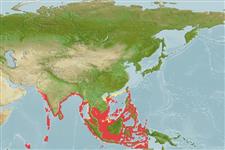Common names from other countries
Teleostei (teleosts) >
Eupercaria/misc (Various families in series Eupercaria) >
Lutjanidae (Snappers) > Lutjaninae
Etymology: Lutjanus: Malay, ikan lutjan, name of a fish.
More on author: Valenciennes.
Environment: milieu / climate zone / depth range / distribution range
Ecology
Marine; reef-associated. Tropical; 24°N - 12°S, 59°E - 133°E (Ref. 55)
Indian Ocean: Zanzibar, Seychelles and Madrakah, southern Oman; up to Sri Lanka, and India. Formerly confused with Lutjanus xanthopinnis known from the Indo-West Pacific region.
Size / Weight / Age
Maturity: Lm ? range ? - ? cm
Max length : 30.0 cm TL male/unsexed; (Ref. 55); common length : 20.0 cm TL male/unsexed; (Ref. 55)
Dorsal
spines
(total): 10;
Dorsal
soft rays
(total): 13;
Anal
spines: 3;
Anal
soft rays: 9. This species is distinguished by the following characters: no scales on the preopercular flange; scales on the cheek 7-8 rows; with a rounded posterior nostril; predorsal scales extending to about the level of the posterior edge of the orbit; with a prominent mid-lateral yellow stripe, from 1.5 to 3 scale rows wide (Ref. 106991).
Adults inhabit coral and rocky reefs (Ref. 55) in coastal areas and outer slopes.
Life cycle and mating behavior
Maturity | Reproduction | Spawning | Eggs | Fecundity | Larvae
Iwatsuki, Y., F. Tanaka and G.R. Allen, 2015. Lutjanus xanthopinnis, a new species of snapper (Pisces: Lutjanidae) from the Indo-west Pacific, with a redescription of Lutjanus madras (Valenciennes 1831). J. Ocean Sci. Found. 17:22-42. (Ref. 106991)
IUCN Red List Status (Ref. 130435)
CITES (Ref. 128078)
Not Evaluated
Threat to humans
Harmless
Human uses
Fisheries: commercial
More information
Common namesSynonymsMetabolismPredatorsEcotoxicologyReproductionMaturitySpawningFecundityEggsEgg development
ReferencesAquacultureAquaculture profileStrainsGeneticsElectrophoresesHeritabilityDiseasesProcessingMass conversion
Tools
Special reports
Download XML
Internet sources
Estimates based on models
Preferred temperature (Ref.
115969): 27.3 - 29.2, mean 28.6 (based on 1038 cells).
Phylogenetic diversity index (Ref.
82804): PD
50 = 0.5000 [Uniqueness, from 0.5 = low to 2.0 = high].
Bayesian length-weight: a=0.01479 (0.00706 - 0.03101), b=2.97 (2.81 - 3.13), in cm Total Length, based on LWR estimates for this Genus-body shape (Ref.
93245).
Trophic level (Ref.
69278): 3.8 ±0.6 se; based on size and trophs of closest relatives
Resilience (Ref.
120179): Medium, minimum population doubling time 1.4 - 4.4 years (Preliminary K or Fecundity.).
Fishing Vulnerability (Ref.
59153): Low vulnerability (20 of 100).
